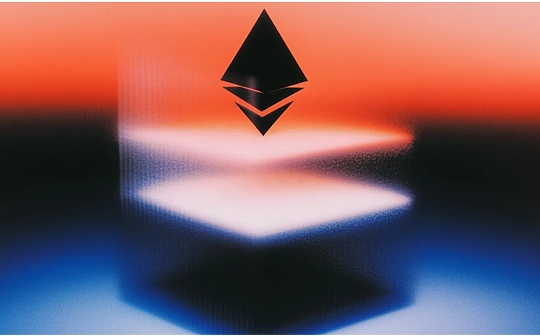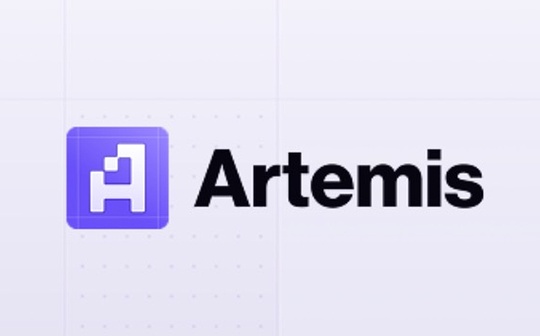
Author: Zheng Jie, Artemis Data Researcher; Cosmo Jiang, Portfolio Manager at Pantera Capital Translated by: Shaw, Bitchain Vision
summary: Currently, cryptocurrency data providers show huge differences in supply indicators for the same token, which greatly affects market value or valuation multiples (such as market value/revenue).Artemis and Pantera Capital proposed a simple framework called “Outstanding Supply” (Outstanding Supply) that is, the total supply – the total holdings of the agreement, which is similar to the “Outstanding Shares” in the stock market, that is, the total number of shares issued – the total number of shares in the treasury.Our goal is to provide investors with a clearer comparison of valuations between tokens and stocks.
introduction
When investors purchase stocks, in order to understand the issuance of stocks, they usually pay attention to the following key data:
-
Legal shares (number of authorized shares): The total number of shares allowed by the company to issue in accordance with the law.
-
Issued shares (number of issued shares): The number of shares actually issued by the company since its establishment.
-
Circular shares (number of circulating shares): The number of shares currently held by all investors, this data does not include the treasury shares held by the company itself.
-
Free circulating shares (number of circulating shares): The number of shares that are actually available for the public to trade.
Why is it important?
These data are crucial to investors and are mainly reflected in the following aspects:
-
Definition of ownership: Through these data, investors can clarify the proportion of the economic equity of the company they have purchased.
-
Supply risk assessment: Can help investors predict the possible increase in stock supply in the future.
-
Liquidity considerations: Helps investors measure the difficulty of trading the stock in the market, that is, the possibility of trading without significantly affecting the stock price.

Source: Artemis
Let’s take a look at Uber.
-
Authorized shares: 5 billion shares → The largest number of shares approved by Uber.Open market investors almost never mention authorized shares.
-
Issued shares: Approximately 2.1 billion shares → The number of shares actually issued by Uber
-
Distribution shares: Approximately 2.09 billion shares → The number of shares currently held by Uber investors.This is the number of shares that open market investors really care about.
-
Free circulating shares: About 2.07 billion shares → the number of shares that can actually be circulated in the market.
Now, imagine that if Uber is valued based on its authorized shares, it would look like a company with a market capitalization of $469 billion and a 70-times P/E ratio, which doesn’t seem reasonable.Authorized shares are not the figure used by any investor to value a company, because multiplying authorized shares by the share price has no economic significance.
However, in fact, investors evaluate their value based on Uber’s outstanding shares (about 2.09 billion shares), which puts Uber’s market capitalization close to $195.9 billion (as of August 17, 2025) with an expected price-to-earnings ratio of 30 times.The outstanding shares reflect the economic reality of who owns a share of the company’s value.
The current problems with token supply indicators
In the cryptocurrency space, most investors only focus on tokensCirculation supply.
Circulating Supply = Tokens available for public trading
However, the definition of circulation supply varies greatly:
-
Some projects calculate locked tokens, while others do not
-
Some will calculate the reserve wallet, while others will not
-
Some will ignore destroyed tokens
-
Some projects will release tokens quietly without any clear disclosure
On the other hand, investors often see FDV (completely diluted valuation)
FDV (full dilution valuation) = Token price × Total supply
It’s like valuing Uber, as if all its existing shares will be traded tomorrow, or the $469 billion market capitalization as mentioned above, which is also incorrect economically.
Therefore, investors can only choose between: FDV (i.e. all issued tokens), or circulating supply (confused and inconsistent definitions, and critically, unattended and uncirculating tokens are often excluded).
Why “issued supply” is a practical intermediate value
The role of “issued supply” is reflected here.”Issued Supply” counts all created tokens, and excludes parts held by the agreement but are actually not circulated, such as tokens held by foundations, reserves or labs.
It can be understood as the cryptocurrency field“Disclosure Shares”concept.
Compared to fully diluted valuations, “issued supply” is more relevant;
Compared with circulating supply, the definition of “issued supply” is clearer and the standards are more unified.
“Issued Supply” is an intermediate solution based on economic reality, worthy of investors’ trust.
Real token examples – Hyperliquid

Source: Artemis
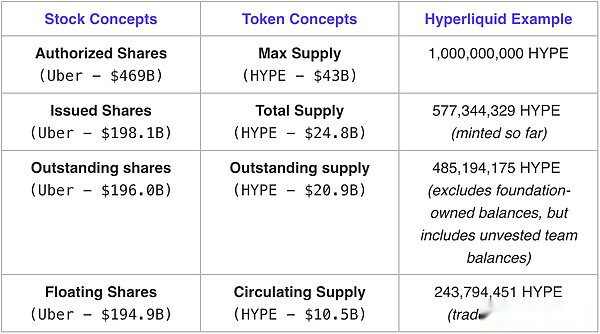
Source: Artemis
Why is “issued supply” crucial
For many years, in the cryptocurrency field, token valuations have usually defaulted to “Fully diluted valuation (FDV) = Maximum supply × Price” approach. This is similar to when valuing Uber, assuming that all its 5 billion authorized shares have been actually issued. This brings Uber to about $469 billion, rather than the market cap you usually see on Google Finance.
Then the industry switched to useTotal SupplyAs a measure, this still overvalues because the total supply contains the agreement holdings.Take Hyperliquid as an example. Of the 1 billion HYPE tokens it issued, 6% (i.e. 60 million tokens) are held by the Hyper Foundation.These tokens belong to the agreement and can be used for purposes such as agreement operations, project funding or team compensation payments.From an economic perspective, they are essentially different from the tokens held by investors.
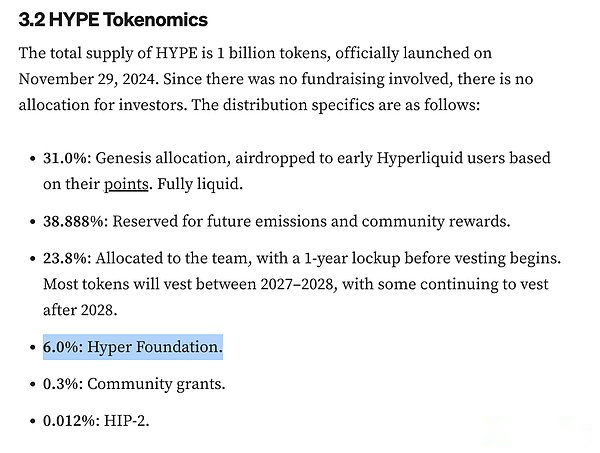
Based on this, Hyperliquid’s issued supply (approximately US$20.8 billion) provides us with the closest “real” perspective of market value.This concept is similar to the concept of outstanding shares in the stock market, which covers all tokens held by investors while excluding treasury shares.
In contrast, Hyperliquid’s valuation of circulating supply (about US$10.5 billion) can more accurately reflect the liquidity and tradability of HYPE tokens in the actual market, similar to the concept of free-flowing stocks in the stock field.
These supply indicators are important and often lead to artificial overestimation when we calculate valuation multiples such as price-to-earnings ratio (P/E) or price-to-sales ratio (P/S) based on a complete dilution valuation (FDV).This phenomenon is particularly obvious in comparison and analysis. Compared with other projects in the same industry, projects like Hyperliquid that have a large amount of supply that has not yet entered the circulation link will be adversely affected in valuation.
Note: Our definition of “total supply” is different from CoinGecko.CoinGecko includes the tokens in the calculation scope regardless of ownership of the tokens when counting the total supply.Our calculation method is different, deducting permanent destruction and the number of tokens that have not yet been generated to ensure that the “total supply” can truly and accurately reflect the number of tokens that actually exist and will have an impact on the project valuation.
Causes of differences in existing data
Currently, when focusing on $HYPE tokens, most investors will find that the data obtained differs significantly depending on the data sources:
-
According to the fully diluted circulation valuation (Outstanding FDV) data provided by DefiLlama, Hyperliquid has a market value of up to US$27.8 billion.Assuming the token price is US$43, it can be concluded through simple calculations that the number of issued and circulated tokens they have identified is about 647 million.However, the reality is that as of now, the total number of tokens minted by Hyperliquid is only 577 million.It can be seen that this data from DefiLlama is significantly overestimated.
-
CoinGecko is valued at circulating supply at $14.5 billion.Based on this valuation and the current token price, it means that they regard about 337 million tokens as in circulation.
However, this data is likely to be overestimated.The reason is that CoinGecko did not completely exclude all wallets held by the protocol during the statistical process, such as the Hyper Foundation, community grant wallets, and tokens in the aid fund wallet.In the actual market environment, many of the tokens in these wallets have not yet entered the public trading market for circulation, so the number of “real” circulating tokens should be lower than the values counted by CoinGecko.
The challenge is that these differences can lead to a variance of project valuation up to billions of dollars.In the absence of unified and clear standards, different researchers or investors are likely to have completely different understandings of their actual scale when analyzing the same token.
To sum up, this fully demonstrates why we urgently need to clarify the “issued supply” and build a more accurate and reasonable concept of “circulating supply”.The concept of “issued supply” provides a transparent and analogy standard for research and analysis in the cryptocurrency field, which helps improve the accuracy and comparability of research.
Artemis solution: issued supply and more optimized circulation supply
Total supply
Definition: Total supply refers to the number of tokens that have been created (minted) and the number of tokens that have been destroyed needs to be subtracted.It can be simply compared to the issued shares in the stock field.
Total supply calculation formula is: Total supply = Maximum supply – Number of tokens not created – Number of tokens destroyed
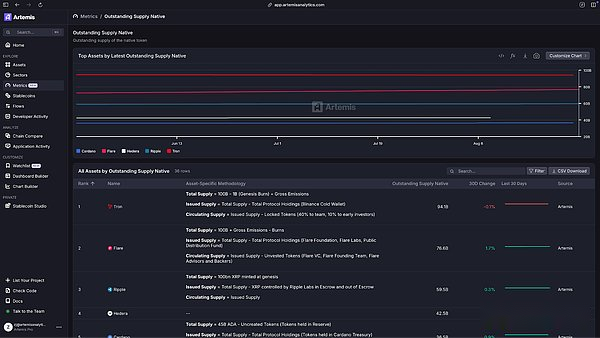
Source: Artemis
Issued supply (new indicator)
Definition: The issued supply covers all tokens that are currently in effect, but does not include parts held by the agreement itself (such as foundations, DAOs, labs, or tokens in locked distribution contracts).We exclude tokens held by the agreement because such tokens are similar to stocks in stocks.Although they already exist, they are not held by external investors.Only tokens held by external entities can truly reflect the real ownership situation, market liquidity and market value.This indicator can be understood analogically as the concept of circulating shares in stocks.
Issued Supply = Total Supply – Total Holdings of Agreement
Description of each composition
Total Agreement Holdings: The total amount of agreement holdings refers to the number of tokens controlled by the main management parties of the agreement (DAO, foundation, laboratory, etc.).Specifically cover the following categories:
-
DAO/Funded: Tokens held by entities that assume the responsibility of governing the agreement or promoting their development.The holding of such tokens is intended to ensure the orderly operation and long-term development of the agreement, and its ownership and control are closely linked to the strategic direction of the agreement.
-
Laboratory hold: In the absence of an independent foundation, some laboratory entities actually assume the role of the party to the agreement.These laboratories hold tokens, usually in the form of ecosystem funds or distribution managers, to support the construction and maintenance of protocol ecosystems.
-
Programmatic distribution contracts: A mechanism implemented through smart contract technology, which can automatically release tokens into the protocol ecosystem according to preset times and rules.This method helps ensure the reasonable allocation and gradual circulation of tokens in the ecosystem.
-
Idle funds: Tokens stored in on-chain funds, which are managed by the verifier governance system.In this model, the use and allocation of tokens must be decided through a decentralized voting mechanism, and these tokens are always under custody of the agreement until they are finally released.
-
Undestroyed repurchase reserves: The tokens repurchased through repurchase operations in the agreement, but have not been destroyed yet.These tokens are temporarily in reserve, and their subsequent disposal methods may have an impact on the economic model of the agreement and market supply and demand.
More optimized circulation supply (revised indicators)
Definition: Circulating supply refers to the number of tokens that can be actually traded in the market at present.This metric excludes tokens that are locked, tokens that have not been fully unlocked due to the restrictions on the ownership clause, and tokens in reserve wallets with poor liquidity.It can be simply compared to the concept of free-flowing shares in the stock market, aiming to more accurately reflect the actual tradable scale and liquidity status of the token in the market.
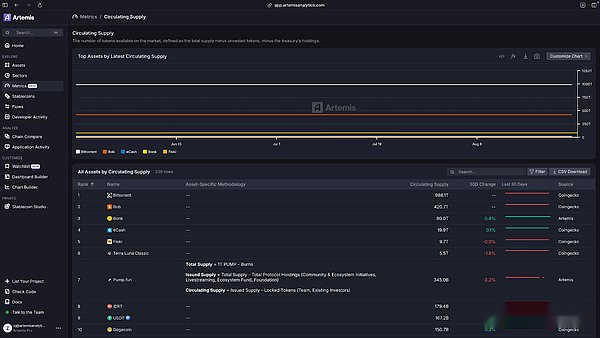
Source: Artemis
The calculation formula for circulating supply is: circulating supply = circulating supply – the number of locked tokens
Why are these two indicators needed
-
Improve transparency: These two indicators can clearly present the differences between the overall creation of modern coins and the parts that can be actually used for trading, providing market participants with a comprehensive and clear data perspective.
-
Optimize risk assessment: With these two indicators, investors and researchers can more accurately estimate the number of tokens that may enter the market circulation link in the future, thereby more accurately assessing potential market risks.
-
standardization: In the context of numerous and complex projects in the cryptocurrency field, the clear definition of these two indicators helps to eliminate the ambiguity of data statistics and interpretation of different projects, and establish unified and standardized measurement standards for the entire industry.
-
Accurate valuation: A carefully considered and optimized circulation supply indicator can provide more accurate data support for the market value evaluation of cryptocurrency projects, thereby helping market participants make more reasonable investment decisions.
-
Project Comparability: By using these two indicators, different cryptocurrency projects can be compared and analyzed under unified standards, making the horizontal comparison in the industry more scientific, objective and fair, and helps to tap the real value and potential of the project.
Summarize
In traditional stock markets, investors can obtain clear and clear information about the number of stocks issued and the supply that may flow into the market without guessing.This high level of information transparency establishes a solid foundation of trust for market participants.
The cryptocurrency industry also needs to achieve this transparency.If the cryptocurrency industry expects to gain the trust and recognition of institutional investors, it must meet the transparency standards that meet institutional investment requirements.The proposal and application of the two indicators of “issued supply” and a more optimized “circulating supply” enable investors in the cryptocurrency field to enjoy similar transparency as those of the traditional stock market in terms of data acquisition and analysis, which is very meaningful for promoting the healthy and orderly development of the cryptocurrency market.




